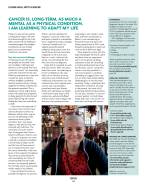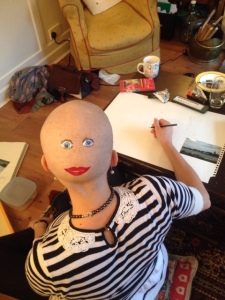2022 marks 20 years of Southampton Bone Marrow Transplant Unit. On the strength of their outcomes, they have also been named the best unit for allogeneic stem cell transplants in Europe. I was invited to deliver a speech at the online celebration, here is the full text:
Good afternoon and thank you very much for this opportunity to address you all and share some of my reflections as a patient of Southampton’s Bone Marrow Transplant Unit for the past eight years.
I’d like to focus today on three factors which have contributed towards Southampton’s incredible status as the best unit in Europe for allogenic transplants: teamwork, trust, and transitions. But before I talk about these, firstly a little about me and how I came to be one of Southampton’s patients.
In July 2014 I was taken by ambulance to A&E in Portsmouth. I was diagnosed with Stage IVb Hodgkin’s Lymphoma and after three weeks I was finally well enough to be discharged as a new cancer patient. In the Summer and autumn of 2014, I had radiotherapy and almost 6 months of increasingly aggressive chemotherapy before my Portsmouth team told me that the best remaining chance of a cure was an allogenic Stem Cell transplant at the Southampton Bone Marrow transplant Unit.
I met Debbie, Joan, and Sarah for the first time at the beginning of 2015 and we began the preparations for my transplant. I had six months of immunotherapy and then in June 2015 I was admitted to C6 for my transplant. I was incredibly lucky, and my brother was a match, so he was my stem cell donor. He has great memories of being treated by Kate Hill and the team at Southampton.
My transplant alone was unfortunately not curative. Initially I had donor lymphocyte infusions on C7 with radiotherapy to target the residual disease. By summer 2017, it became apparent that this would not be enough, and I switched back to a systemic treatment. Firstly, Brentuximab Verdotin and then this too failed. Finally, at the beginning of 2018 I switched to Nivolumab and I had 2 years of fortnightly infusions, ultimately ending with the start of the first lockdown in March 2020. Miraculously I have been treatment free and in remission ever since.
My experience of cancer treatment was not a simple one but, as the video will show, none of the stories of patients at the Bone Marrow Transplant unit are straightforward. And this makes the unit’s achievements and success rate all the more impressive and awe inspiring.
I’ve thought a lot about what makes the Southampton Bone Marrow Transplant Unit so brilliant, and I’ve come up with three themes: teamwork, trust, and transitions.
My first theme is teamwork. Debbie referenced this in her remarks at the beginning of the staff video, describing the outcomes as ‘testament to the teamwork’. The teamwork is evident from the outset as a patient. One of the other patients in the video shares his appreciation of the team from consultants, to ‘Rockstar’ nurses, to cleaners and people serving meals on C6. I’d like to echo his thanks and add to the immense team list the Health Care Assistants who manage the outpatient clinics. Their friendly greetings set the tone for my visits to Southampton today. It was also fascinating to see a glimpse of the work that goes on behind the scenes in the Staff Video. Like every other piece of the immense and gleaming puzzle, without the lab staff I wouldn’t be here today.
My second theme is trust. The team at Southampton inspires total trust in their treatment and this is a critical part of their success. I recently listened to a podcast interviewing the great Stephen Fry. Reflecting on his experiences of prostate cancer, he was asked how he felt about the military metaphors used to describe cancer. Stephen Fry replied that he didn’t identify with the military metaphors and neither do I. He explained, being treated for cancer is not a battle, it is instead a submission. I couldn’t agree more, I didn’t ‘fight’ my cancer, I have not ‘beaten’ it now and if my treatment had not been successful, I would not have ‘succumbed’ to my illness. Instead, I found a way to live with cancer while I submitted to my immense NHS treatment. Placing total trust in the team at Southampton was liberating for me. I never once questioned their decisions which left me space to focus on the things I could do to keep well around my cancer.
The third and final theme I want to speak about today is transitions. It’s perhaps less obvious what I mean when I say transitions and I admit, I partly chose the word because it begins with a T, which fits nicely with Transplant, Teamwork & Trust. But, if we think about the word in terms of managing change, transitions are also something the Southampton Bone Marrow Transplant unit excels at. Because patients and their lives are transitioning and changing all the time, and Southampton oversaw some fairly major ones for me. For example, the transition between someone being informed of the 10% chance of developing a life-threatening complication during transplant, to someone who put those worries to one side, and actually underwent the transplant. Or the transition between someone with an A- blood group to a person with an AB- blood group (with a whole new immune system to boot!) Or the transition between the person lying without an immune system in a protective hospital cocoon to the busy healthy teacher that I am today. For all these fantastic life altering processes, I am so grateful that I was under Southampton’s care.
To conclude, teamwork, trust, and transition. Three reasons why the Southampton Bone Marrow Transplant unit is Europe’s best. And one final thought from me before we watch the video. I’m not a religious person but sometimes I think there must be some greater celestial force determining our fates. Because although my life has been indescribably hard at times, it’s always been manageable and, within all the hardship, there has always been good fortune. I’ll forever be so lucky and thankful that my lymphoma was treated on the south coast and my transplant happened at Southampton.
























